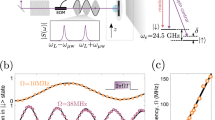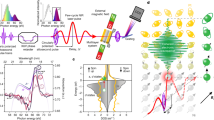Abstract
A single electron or hole spin trapped inside a semiconductor quantum dot forms the foundation for many proposed quantum logic devices1,2,3,4,5,6. In group III–V materials, the resonance and coherence between two ground states of the single spin are inevitably affected by the lattice nuclear spins through the hyperfine interaction7,8,9, while the dynamics of the single spin also influence the nuclear environment10,11,12,13,14,15. Recent efforts12,16 have been made to protect the coherence of spins in quantum dots by suppressing the nuclear spin fluctuations. However, coherent control of a single spin in a single dot with simultaneous suppression of the nuclear fluctuations has yet to be achieved. Here we report the suppression of nuclear field fluctuations in a singly charged quantum dot to well below the thermal value, as shown by an enhancement of the single electron spin dephasing time T2*, which we measure using coherent dark-state spectroscopy. The suppression of nuclear fluctuations is found to result from a hole-spin assisted dynamic nuclear spin polarization feedback process, where the stable value of the nuclear field is determined only by the laser frequencies at fixed laser powers. This nuclear field locking is further demonstrated in a three-laser measurement, indicating a possible enhancement of the electron spin T2* by a factor of several hundred. This is a simple and powerful method of enhancing the electron spin coherence time without use of ‘spin echo’-type techniques8,12. We expect that our results will enable the reproducible preparation of the nuclear spin environment for repetitive control and measurement of a single spin with minimal statistical broadening.
This is a preview of subscription content, access via your institution
Access options
Subscribe to this journal
Receive 51 print issues and online access
$199.00 per year
only $3.90 per issue
Buy this article
- Purchase on Springer Link
- Instant access to full article PDF
Prices may be subject to local taxes which are calculated during checkout




Similar content being viewed by others
References
Berezovsky, J. et al. Picosecond coherent optical manipulation of a single electron spin in a quantum dot. Science 320, 349–352 (2008)
Bracker, A. S. et al. Optical pumping of the electronic and nuclear spin of single charge-tunable quantum dots. Phys. Rev. Lett. 94, 047402 (2005)
Gammon, D. & Steel, D. G. Optical studies of single quantum dots. Phys. Today 55, 36–41 (2002)
Gerardot, B. D. et al. Optical pumping of a single hole spin in a quantum dot. Nature 451, 441–444 (2008)
Kim, D. et al. and nondestructive measurement in a quantum dot molecule. Phys. Rev. Lett. 101, 236804 (2008)
Kroutvar, M. et al. Optically programmable electron spin memory using semiconductor quantum dots. Nature 432, 81–84 (2004)
Merkulov, I. A., Efros, A. L. & Rosen, M. Electron spin relaxation by nuclei in semiconductor quantum dots. Phys. Rev. B 65, 205309 (2002)
Petta, J. R. et al. Coherent manipulation of coupled electron spins in semiconductor quantum dots. Science 309, 2180–2184 (2005)
Baugh, J., Kitamura, Y., Ono, K. & Tarucha, S. Large nuclear Overhauser fields detected in vertically coupled double quantum dots. Phys. Rev. Lett. 99, 096804 (2007)
Tartakovskii, A. I. et al. Nuclear spin switch in semiconductor quantum dots. Phys. Rev. Lett. 98, 026806 (2007)
Eble, B. et al. Dynamic nuclear polarization of a single charge-tunable InAs/GaAs quantum dot. Phys. Rev. B 74, 081306 (2006)
Greilich, A. et al. Nuclei-induced frequency focusing of electron spin coherence. Science 317, 1896–1899 (2007)
Koppens, F. H. L. et al. Control and detection of singlet-triplet mixing in a random nuclear field. Science 309, 1346–1350 (2005)
Maletinsky, P., Lai, C. W., Badolato, A. & Imamoglu, A. Nonlinear dynamics of quantum dot nuclear spins. Phys. Rev. B 75, 035409 (2007)
Vink, I. T. et al. Locking electron spins into magnetic resonance by electron-nuclear feedback. Preprint at <http://arxiv.org/abs/0902.2659> (2009)
Reilly, D. J. et al. Suppressing spin qubit dephasing by nuclear state preparation. Science 321, 817–821 (2008)
Xu, X. D. et al. Fast spin state initialization in a singly charged InAs-GaAs quantum dot by optical cooling. Phys. Rev. Lett. 99, 097401 (2007)
Xu, X. et al. Coherent population trapping of an electron spin in a single negatively charged quantum dot. Nature Phys. 4, 692–695 (2008)
Harris, S. E. Electromagnetically induced transparency. Phys. Today 50, 36–42 (1997)
Stepanenko, D., Burkard, G., Giedke, G. & Imamoglu, A. Enhancement of electron spin coherence by optical preparation of nuclear spins. Phys. Rev. Lett. 96, 136401–136404 (2006)
Braun, P. F. et al. Direct observation of the electron spin relaxation induced by nuclei in quantum dots. Phys. Rev. Lett. 94, 116601 (2005)
Eble, B. et al. Hole–nuclear spin interaction in quantum dots. Phys. Rev. Lett. 102, 146601–146604 (2009)
Fischer, J., Coish, W. A., Bulaev, D. V. & Loss, D. Spin decoherence of a heavy hole coupled to nuclear spins in a quantum dot. Phys. Rev. B 78, 155329 (2008)
Kikkawa, J. M. & Awschalom, D. D. All-optical magnetic resonance in semiconductors. Science 287, 473–476 (2000)
Gammon, D. et al. Nuclear spectroscopy in single quantum dots: nanoscopic raman scattering and nuclear magnetic resonance. Science 277, 85–88 (1997)
Ware, M. E. et al. Polarized fine structure in the photoluminescence excitation spectrum of a negatively charged quantum dot. Phys. Rev. Lett. 95, 177403 (2005)
Xu, X. et al. Coherent optical spectroscopy of a strongly driven quantum dot. Science 317, 929–932 (2007)
Scheibner, M. et al. Optically mapping the electronic structure of coupled quantum dots. Nature Phys. 4, 291–295 (2008)
Alen, B. et al. Stark-shift modulation absorption spectroscopy of single quantum dots. Appl. Phys. Lett. 83, 2235–2237 (2003)
Koudinov, A. V., Akimov, I. A., Kusrayev, Yu. G. & Henneberger, F. Optical and magnetic anisotropies of the hole states in Stranski-Krastanov quantum dots. Phys. Rev. B 70, 241305 (2004)
Acknowledgements
We thank P. L. McEuen, L.-M. Duan, and D. Kim for discussions. This work is supported by US ARO, AFOSR, ONR, NSA/LPS, and FOCUS-NSF.
Author information
Authors and Affiliations
Corresponding author
Supplementary information
Supplementary Information
This file contains Supplementary Data and Notes, Supplementary Figures 1-5 with Legends and Supplementary References. (PDF 473 kb)
Rights and permissions
About this article
Cite this article
Xu, X., Yao, W., Sun, B. et al. Optically controlled locking of the nuclear field via coherent dark-state spectroscopy. Nature 459, 1105–1109 (2009). https://doi.org/10.1038/nature08120
Received:
Accepted:
Issue Date:
DOI: https://doi.org/10.1038/nature08120
This article is cited by
-
Approaching a fully-polarized state of nuclear spins in a solid
Nature Communications (2024)
-
Post-processing of real-time quantum event measurements for an optimal bandwidth
Scientific Reports (2023)
-
The squeezed dark nuclear spin state in lead halide perovskites
Nature Communications (2023)
-
Quantum State Recovery Via Environment-assisted Measurement and Weak Measurement
International Journal of Theoretical Physics (2022)
-
Photonic scheme of quantum phase estimation for quantum algorithms via quantum dots
Quantum Information Processing (2022)
Comments
By submitting a comment you agree to abide by our Terms and Community Guidelines. If you find something abusive or that does not comply with our terms or guidelines please flag it as inappropriate.



